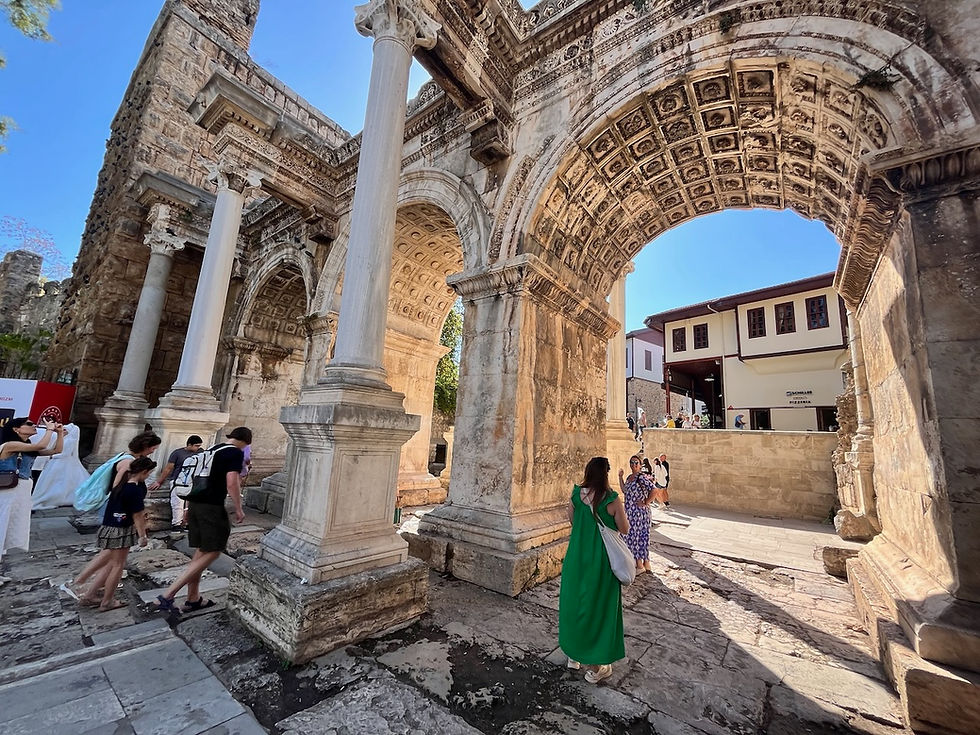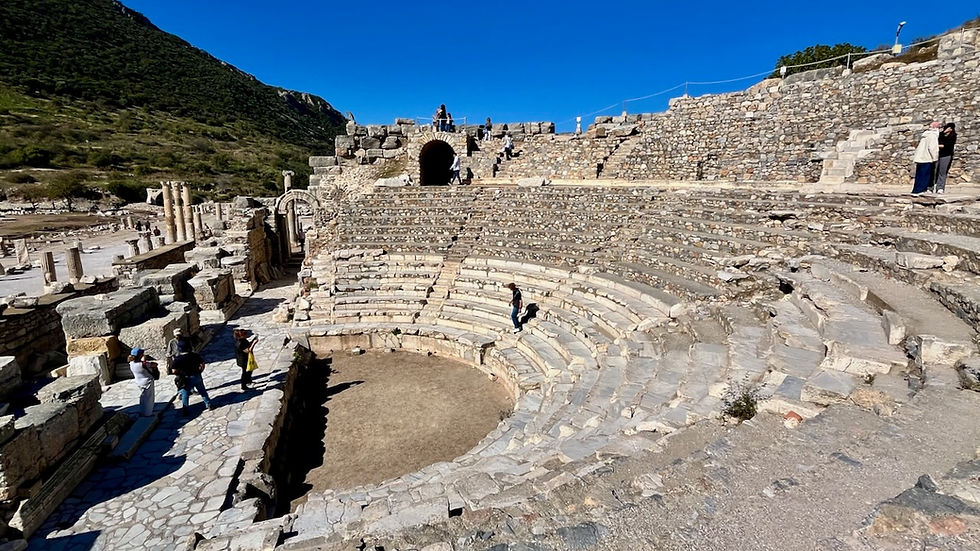Our Last 4 Days in Turkey
- uniquejt
- Nov 10
- 9 min read
Updated: Nov 11

From Cappadocia we flew to the coastal city of Antalya. It is one of the largest cities in Turkey and the capital of Antalya Province, the fifth-most populous province. Recognized as the "capital of tourism" in Turkey and a pivotal part of the Turkish Riviera, Antalya sits on Anatolia's southwest coast, flanked by the Taurus Mountains. We arrived on Sunday, October 26 in the evening and took a taxi to the hotel. We decided to get a family-style hotel room so we could all be together. It had three separate sleeping areas behind the main door off the street. We took the downstairs room that shared a kitchenette and large common dining area with an enclosed courtyard. Richard and Portia took the upstairs bedroom with a separate bedroom for the boys. When we arrived we really didn't know what we had until the morning. It turned out the courtyard was open to the sky with a swing and outdoor furniture.
The morning started with our typical Turkish breakfast fare of yogurt with add-ons, a variety of meats, cheeses and eggs, and of course olives. Turks have a deep cultural and culinary relationship with olives, which are an indispensable part of their cuisine especially for breakfast, and Turkey is one of the world's top producers of olives and olive oil.
Antalya's rugged coastline is characterized by dramatic cliffs, rocky outcrops, and hidden coves, shaped by the Taurus Mountains descending to the Mediterranean Sea. This dramatic terrain is complemented by the region's clear blue waters and dotted with pine forests. For those looking to explore, the Lycian Way offers hiking routes along these rugged, scenic paths. This region is referred to as the Turkish Riviera, also known popularly as the Turquoise Coast, an area of southwest Turkey encompassing the provinces of Antalya and Muğla, and to a lesser extent Aydın, southern İzmir and western Mersin. This region of Turkey, located along the Mediterranean and Aegean coasts, is characterized by its climate, coastal geography, mountainous terrain, beaches, and numerous natural and archaeological sites. Extending over approximately 620 miles kilometers of shoreline, it is frequently visited by both domestic and international tourists.

The coastline is regarded as a cultural trove that provides background on a fascinating mixture of factual and mythological individuals, conflicts and events, and has frequently been referred to in the folklore of various cultures throughout history. As such, it is regarded as the home of scholars, saints, warriors, kings, and heroes, as well as the site of numerous well-known myths. Mark Antony of the Roman Republic is said to have picked the Turkish Riviera as the most beautiful wedding gift for his beloved Cleopatra of Egypt. Saint Nicholas, who later became the basis of the Santa Claus legend, was born in Patara, a small town close to present-day Demre. Herodotus, regarded as the "father of History", was born in Bodrum (ancient Halicarnassus) in c. 484 BC. The volcanic mountains to the west of Antalya, near Dalyan, are believed to have been the inspiration for the mythical Chimera — the fire-breathing monster that Bellerophon slew.
Among the archaeological points of interest are two of the Seven Wonders of the Ancient World: the ruins of the Mausoleum at Halicarnassus; and the Temple of Artemis in Ephesus.
Once everyone was ready, we all took a walk to view the ocean and explore the old section of the city. Classic old city narrow streets with pavers wind through to coastline restaurants, parks and a harbor. The city was formerly known as Attalia and was founded in around 200 BC by King Attalus II of Pergamon. Attalia was soon conquered by the Romans. Roman rule saw the city thrive, including the construction of several new monuments, such as Hadrian's Gate which we visited.

While the city itself only has modest elevation changes, Antalya has high mountains in all directions from its interior. With moisture being trapped, the local climate has high winter rainfall, while the interior bay setting results in very hot summers for a coastal city.

Antalya is Turkey's biggest international sea resort on the Turkish Riviera. Large-scale development and governmental funding has made it a prime destination for tourists. Antalya is currently the fourth-most visited city in the world, trailing behind only Istanbul, London, and Dubai, attracting more than 16.5 million foreign visitors in 2023.
On our last night all together, we enjoyed a delicious seafood dinner overlooking the Hıdırlık Tower, a Roman-era coastal tower in Antalya built around the 2nd century AD. Located at the edge of the Old Town (Kaleiçi) and Karaalioglu Park, it offers panoramic views of the Mediterranean Sea and has a history of possibly serving as a lighthouse, tomb, or fortification. Although the tower cannot be entered, its exterior can be viewed and the surrounding area is a popular spot for enjoying sunsets and exploring the nearby historical sites.
Tuesday, October 28 and after twelve days together with the Schneider family, Karen and I said our farewells to our traveling family, departed the hotel at around 11 AM and took a taxi to the Antalya bus depot to catch our reservation on the Omio overland bus to Izmir, Turkey. This six hour journey would take us north through the mountains and pine forests to our last planned stop in Turkey, the ancient city of Ephesus near Izmir. Rather than fly, we decided to enjoy a six hour bus trip through the country to explore more of the interior. The bus was very comfortable and they handle these trips like a plane flight with food snacks on board. The biggest difference is there are no restrooms on board so we planned ahead.

Turkey is an amazing country with massive mountain ranges and extensive forested areas. In the valleys we passed through a collective of farms and orchards that provide the country with fruits and vegetables. We observed ancient orchards of olive trees with trunks the size of old oak trees. Oranges and other citrus trees are abundant along with the Turks favor fruit, the Pomegranate.
Turks have a deep cultural and symbolic connection to pomegranates, which are seen as a symbol of fertility, abundance, prosperity, and good fortune. This significance is expressed through traditions like smashing the fruit at weddings and New Year's to bring good luck and abundance, as well as its use in art and design, and as a popular culinary ingredient.
At the end of this day's journey we hired a taxi who delivered us to our hotel near the airport for our two night stay. The next morning we were scheduled to be picked up for our day long Ephesus tour. The airport hotel was the pick up location for our all day tour planned for Wednesday, October 29.
Promptly the tour bus picked us up at 8:40 AM. We were in a group with eleven other guests, a driver and our tour guide. Our schedule included a visit to a classic Turkish pottery merchant, the ancient city of Ephesus, a stop for lunch then on to "the House of Mary" and the remains of the one of the ancient wonders of the world, the Temple of Artemis.
The pottery craftsman shop was massive. It is the end of the season so the owner was cutting the prices in half to try and make a sale. They create elaborate designs and beautiful colors, but not our style. During the tour, the owner showed us what makes this pottery so unique. Historically, some Turkish ceramics, known as "moonstone" ceramics, may have gotten their glow from being baked with ground-up moonstones mixed into the clay or glaze. This technique creates a unique luminescence where the piece appears to glow from within, especially when light hits it.


Our tour bus departed from here for the ancient city of Ephesus. These well-preserved ruins are located on the Aegean coast of modern-day Turkey, near Selçuk and Kuşadası. Once a major Greek and Roman city, it is now a UNESCO World Heritage site renowned for structures like the Library of Celsus and the Great Theatre, with an estimated population of over 200,000 at its peak. It's a historically significant site for both its Roman-era grandeur and its role in early Christianity.







Ephesus is biblically significant as a major center for early Christianity where figures like the Apostle Paul ministered, leading to the writing of the Book of Ephesians and the formation of a prominent church.
Here's a list of some of the biblical figures and events that make Ephesus so significant:
• Apostle Paul: Paul spent considerable time in Ephesus, using its strategic location to spread Christianity throughout the region. His ministry there was marked by miracles and significant growth, but also opposition from those who profited from idol worship.
• Book of Ephesians: Paul wrote his epistle to the church in Ephesus to guide them on unity in Christ, spiritual warfare, and the mystery of the Gospel.
•Timothy: Paul appointed Timothy to lead the church in Ephesus, and addressed him in the pastoral epistles, such as 1 Timothy, with instructions on church order and conduct.
•Saint John: Christian tradition holds that John the Apostle wrote the Gospel of John while living in Ephesus.
•Virgin Mary: According to legend, the Virgin Mary may have spent her final years in a house near Ephesus.
• Book of Revelation: Ephesus is one of the seven churches in Asia to which Jesus sends messages through John, commending their endurance while urging them to return to their "first love".
• Silversmiths' Riot: A well-documented event in the book of Acts recounts a riot incited by Demetrius, a silversmith who feared the Christian faith would hurt his trade of silver shrines to Artemis.
• Burning of Scrolls: After witnessing the power of the Gospel, many who practiced magic in Ephesus publicly burned their scrolls, signifying the transformative power of faith over sorcery.
Seeing Ephesus was such an amazing experience for us both. Just to walk where our first century fellow believers, brothers and sisters in Christ, once walked and lived 2000 years ago was simply mind blowing.

From Ephesus we drove to Selçuk for lunch. Some of our group went to visit the legendary house where Mary lived in her later years and was cared for by the Apostle John. We opted out and rested at the restaurant and enjoyed an afternoon cappuccino. Our last stop for the day was the ruins of the Temple of Artemis.
Temple of Artemis in ancient Ephesus, now in western Turkey, was one of the Seven Wonders of the World. The great temple was built by Croesus, King of Lydia, in about 550 BCE and was rebuilt after being burned by a madman named Herostratus in 356 BCE. The Artemesium was famous not only for its great size, over 350 by 180 feet, but also for the magnificent works of art that adorned it. The temple was destroyed by invading Goths in 262 CE and was never rebuilt. Little remains of the temple (though there are many fragments, especially of sculptured columns, now located in the British Museum). Excavation has revealed traces of both Croesus’s and the 4th-century temple and of three earlier smaller ones.
Honestly, after Ephesus, it was underwhelming until you learn the rest of the story. Much of the temple's materials from the Temple of Artemis were repurposed for new constructions, including the Hagia Sophia in Constantinople and buildings in Ephesus, such as the Basilica of St. John and the Isa Bey Mosque. Other materials were used for lime production, and the remaining debris and rubble were likely reused in the construction of the Byzantine city at Ephesus. Even back then they recycled!

After a full day of exploring we returned to our hotel to rest up for a new day of traveling. In the morning we would leave Turkey and head to Barcelona, Spain; the next chapter in this grand adventure!












Comments